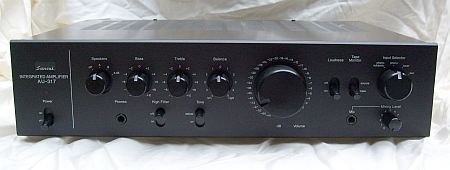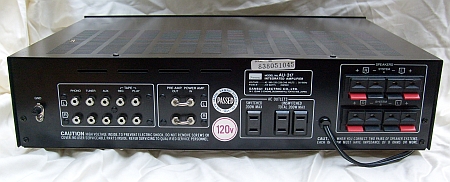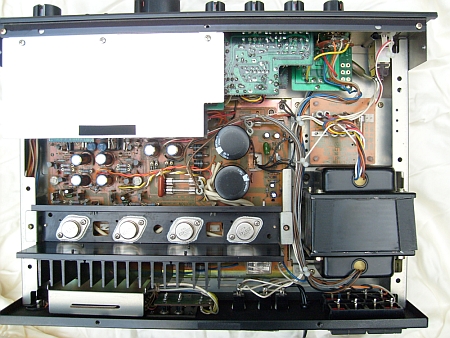| |
 |
| | | |
| |
I bought this rugged little integrated amplifier brand new in Spokane, Washington in 1978. I don't remember what I paid for it, but it seems like it was about $300, a pretty substantial amount of money at the time. I have used the amplifier more-or-less continuously since. It has moved from my main system to the TV system, to where it is now: powering the speakers for the computer on my basement workbench. Mostly, I use it to listen to the radio. It is rated at 50 watts per channel, but it uses 42 VDC rails and has two sets of output transistors (2SA745 and 2SC1403), so the actual power is probably more like 80 to 90 watts per channel. |
|
| | | |
| |
 |
| | | |
| |
I figured that after 31 years the unit was due for a tune-up. I took the cover off and was amazed at how thick the dust and grime was on everything. It's a wonder it worked at all. There was dust from Spokane, Washington and from Polson, Montana (including ash from Mt. St. Helens). There was dust from Jackson, California and Reno, Nevada; and lately dust from eastern Massachusetts. But, she cleaned up shiny as a new penny. |
|
| | | |
| |
 |
| | | |
| |
I found the amplifier's Service Guide on-line some time ago, and it came in very handy. I dismantled the unit as much as I could and carefully cleaned everything. First I vacumed and then blew off as much dust as possible. Then I used water and Q-tips to clean off everything. Several of the larger (470 uF) capacitors had ruptured and leaked, one rather extensively, and I had to use alcohol to get the gunk off the circuit board. I scrubbed the bottom of the circuit boards with alcohol. By the time I was finished, it looked (almost) like new. |
|
| | | |
| |
I replaced all of the electrolytic capacitors with new Panasonic FC series replacements (except for two bi-polar capacitors where I used a different Panasonic series). I used the original values in every case, except for the two, big, 10,000 uF main power supply smoothing caps that I replaced with Panasonic TSHA series 15,000 uF capacitors. These were the biggest I could get in that series at 50 V. 30,000 uF is better than 20,000 uF, I figure. |
|
| | | |
| |
I also adjusted the 0 VDC trimpots for each channel to get the DC offset back down to nearly zero (it wasn't off by much). I then adjusted the bias back to 10 mV. It had drifted to 8.5 V on the left channel and 12.5 V on the right. |
|
| | | |
| |
I replaced the electrolytic capacitors in the pre-amplifier circuit also, but I did not bother to replace the ones in the phono and microphone circuits (and there are a lot of them there!) because I never use these features. I also replaced all of the fuses with new ones. |
|
| | | |
| |
Now this amplfier sounds excellent again. A problem it had with one or the other channel cutting out at low volumes is now fixed. Of course, although it sounds nice, it certainly isn't in the same league with my main P101 amplifier (here). But, restoring this amplifier was sort of like restoring an old classic '70's car. It's a real gem, and so cool looking! Now it's good for another 30 years or so. |
|
| | | |
| |
Back |
|


